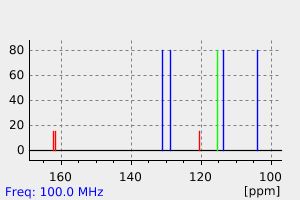3-fluoro-4-vinylphenol
中文名称
——
中文别名
——
英文名称
3-fluoro-4-vinylphenol
英文别名
4-ethenyl-3-fluorophenol
CAS
——
化学式
C8H7FO
mdl
——
分子量
138.141
InChiKey
LFBOTPSZVHTHON-UHFFFAOYSA-N
BEILSTEIN
——
EINECS
——
-
物化性质
-
计算性质
-
ADMET
-
安全信息
-
SDS
-
制备方法与用途
-
上下游信息
-
文献信息
-
表征谱图
-
同类化合物
-
相关功能分类
-
相关结构分类
计算性质
-
辛醇/水分配系数(LogP):2.4
-
重原子数:10
-
可旋转键数:1
-
环数:1.0
-
sp3杂化的碳原子比例:0.0
-
拓扑面积:20.2
-
氢给体数:1
-
氢受体数:2
上下游信息
-
上游原料
中文名称 英文名称 CAS号 化学式 分子量 2-氟-4-羟基苯甲醛 2-fluoro-4-hydroxybenzaldehyde 348-27-6 C7H5FO2 140.114
反应信息
-
作为反应物:描述:3-fluoro-4-vinylphenol 在 ferulic acid decarboxylase from Enterobacter sp. V46E hydratase variant 、 水 作用下, 以 aq. phosphate buffer 、 异丙醇 为溶剂, 反应 3.5h, 以93%的产率得到参考文献:名称:用于取代苯酚的立体选择性羟乙基官能化的多酶一罐级联反应。摘要:据报道,经过重新设计的乙烯基苯酚水合酶作为单一生物催化剂或作为多酶级联反应的一部分,其使用取代的香豆酸或苯酚作为稳定,廉价且易于获得的底物,具有一定的可操作性和底物范围。DOI:10.1021/acs.orglett.8b02058
-
作为产物:描述:(E)-2-fluoro-p-hydroxycinnamate 在 ferulic acid decarboxylase from Enterobacter sp 作用下, 以 aq. phosphate buffer 、 异丙醇 为溶剂, 反应 0.33h, 以99%的产率得到3-fluoro-4-vinylphenol参考文献:名称:用于取代苯酚的立体选择性羟乙基官能化的多酶一罐级联反应。摘要:据报道,经过重新设计的乙烯基苯酚水合酶作为单一生物催化剂或作为多酶级联反应的一部分,其使用取代的香豆酸或苯酚作为稳定,廉价且易于获得的底物,具有一定的可操作性和底物范围。DOI:10.1021/acs.orglett.8b02058
文献信息
-
[EN] ANTIDIABETIC BICYCLIC COMPOUNDS<br/>[FR] COMPOSÉS BICYCLIQUES ANTIDIABÉTIQUES申请人:MERCK SHARP & DOHME公开号:WO2014130608A1公开(公告)日:2014-08-28Novel compounds of the structural formula (I), and the pharmaceutically acceptable salts thereof, are agonists of G-protein coupled receptor 40 (GPR40) and may be useful in the treatment, prevention and suppression of diseases mediated by the G-protein-coupled receptor 40. The compounds of the present invention may be useful in the treatment of Type 2 diabetes mellitus, and of conditions that are often associated with this disease, including obesity and lipid disorders, such as mixed or diabetic dyslipidemia, hyperlipidemia, hypercholesterolemia, and hypertriglyceridemia.
-
METHOD FOR PREPARING p-VINYL PHENOLS申请人:Universitaet Graz公开号:US20180057845A1公开(公告)日:2018-03-01A biocatalytic method is provided for preparing p-vinyl phenols by a three-step, one-pot reaction according to the following reaction scheme: wherein the three steps include: (a) optionally substituted phenol (1) is bound to pyruvic acid (BTS) to form optionally substituted tyrosine (2) by the catalytic action of a tyrosine phenol-lyase (TPL) and in the presence of ammonium ions, (b) ammonia is eliminated from tyrosine (2) by the catalytic action of a tyrosine ammonia-lyase (TAL) or a phenyl ammonia-lyase (PAL) to produce optionally substituted p-coumaric acid (3), and (c) p-coumaric acid (3) is subjected to a decarboxylation reaction by the catalytic action of a phenolic acid decarboxylase (PAD), to produce the desired, optionally substituted p-vinyl phenol (4); and (d) wherein the generated CO 2 is removed from the reaction system to shift the chemical equilibrium of all three reaction steps (a), (b) and (c) towards the product side.
-
Vinylation of Unprotected Phenols Using a Biocatalytic System作者:Eduardo Busto、Robert C. Simon、Wolfgang KroutilDOI:10.1002/anie.201505696日期:2015.9.7conditions to afford the corresponding para‐vinylphenol derivatives while releasing only one molecule of CO2 and water as the by‐products. This transformation was achieved by designing a biocatalytic system that combines three biocatalytic steps, namely the CC coupling of phenol and pyruvate in the presence of ammonia, which leads to the corresponding tyrosine derivative, followed by deamination and decarboxylation
-
ANTIDIABETIC BICYCLIC COMPOUNDS申请人:BROCKUNIER Linda L.公开号:US20160002255A1公开(公告)日:2016-01-07Novel compounds of the structural formula (I), and the pharmaceutically acceptable salts thereof, are agonists of G-protein coupled receptor 40 (GPR40) and may be useful in the treatment, prevention and suppression of diseases mediated by the G-protein-coupled receptor 40. The compounds of the present invention may be useful in the treatment of Type 2 diabetes mellitus, and of conditions that are often associated with this disease, including obesity and lipid disorders, such as mixed or diabetic dyslipidemia, hyperlipidemia, hypercholesterolemia, and hypertriglyceridemia.
-
FLUORINE-CONTAINING CROSSLINKABLE ELASTOMER COMPOSITION AND CROSSLINKED PRODUCT THEREOF申请人:Asahi Glass Company, Limited公开号:EP3031856A1公开(公告)日:2016-06-15To provide a crosslinkable fluorinated elastomer composition which is excellent in crosslinking reactivity and of which a crosslinked product is excellent in heat resistance and chemical resistance. The crosslinkable fluorinated elastomer composition comprises a fluorinated elastomer (e.g. a tetrafluoroethylene/perfluoro(alkyl vinyl ether) copolymer) and an aromatic compound having at least two crosslinkable unsaturated double bonds (e.g. a compound represented by the formula (A-1)), and the crosslinked product is one obtained by crosslinking the crosslinkable fluorinated elastomer composition.
表征谱图
-
氢谱1HNMR
-
质谱MS
-
碳谱13CNMR
-
红外IR
-
拉曼Raman
-
峰位数据
-
峰位匹配
-
表征信息
同类化合物
(βS)-β-氨基-4-(4-羟基苯氧基)-3,5-二碘苯甲丙醇
(S,S)-邻甲苯基-DIPAMP
(S)-(-)-7'-〔4(S)-(苄基)恶唑-2-基]-7-二(3,5-二-叔丁基苯基)膦基-2,2',3,3'-四氢-1,1-螺二氢茚
(S)-盐酸沙丁胺醇
(S)-3-(叔丁基)-4-(2,6-二甲氧基苯基)-2,3-二氢苯并[d][1,3]氧磷杂环戊二烯
(S)-2,2'-双[双(3,5-三氟甲基苯基)膦基]-4,4',6,6'-四甲氧基联苯
(S)-1-[3,5-双(三氟甲基)苯基]-3-[1-(二甲基氨基)-3-甲基丁烷-2-基]硫脲
(R)富马酸托特罗定
(R)-(-)-盐酸尼古地平
(R)-(-)-4,12-双(二苯基膦基)[2.2]对环芳烷(1,5环辛二烯)铑(I)四氟硼酸盐
(R)-(+)-7-双(3,5-二叔丁基苯基)膦基7''-[((6-甲基吡啶-2-基甲基)氨基]-2,2'',3,3''-四氢-1,1''-螺双茚满
(R)-(+)-7-双(3,5-二叔丁基苯基)膦基7''-[(4-叔丁基吡啶-2-基甲基)氨基]-2,2'',3,3''-四氢-1,1''-螺双茚满
(R)-(+)-7-双(3,5-二叔丁基苯基)膦基7''-[(3-甲基吡啶-2-基甲基)氨基]-2,2'',3,3''-四氢-1,1''-螺双茚满
(R)-(+)-4,7-双(3,5-二-叔丁基苯基)膦基-7“-[(吡啶-2-基甲基)氨基]-2,2”,3,3'-四氢1,1'-螺二茚满
(R)-3-(叔丁基)-4-(2,6-二苯氧基苯基)-2,3-二氢苯并[d][1,3]氧杂磷杂环戊烯
(R)-2-[((二苯基膦基)甲基]吡咯烷
(R)-1-[3,5-双(三氟甲基)苯基]-3-[1-(二甲基氨基)-3-甲基丁烷-2-基]硫脲
(N-(4-甲氧基苯基)-N-甲基-3-(1-哌啶基)丙-2-烯酰胺)
(5-溴-2-羟基苯基)-4-氯苯甲酮
(5-溴-2-氯苯基)(4-羟基苯基)甲酮
(5-氧代-3-苯基-2,5-二氢-1,2,3,4-oxatriazol-3-鎓)
(4S,5R)-4-甲基-5-苯基-1,2,3-氧代噻唑烷-2,2-二氧化物-3-羧酸叔丁酯
(4S,4''S)-2,2''-亚环戊基双[4,5-二氢-4-(苯甲基)恶唑]
(4-溴苯基)-[2-氟-4-[6-[甲基(丙-2-烯基)氨基]己氧基]苯基]甲酮
(4-丁氧基苯甲基)三苯基溴化磷
(3aR,8aR)-(-)-4,4,8,8-四(3,5-二甲基苯基)四氢-2,2-二甲基-6-苯基-1,3-二氧戊环[4,5-e]二恶唑磷
(3aR,6aS)-5-氧代六氢环戊基[c]吡咯-2(1H)-羧酸酯
(2Z)-3-[[(4-氯苯基)氨基]-2-氰基丙烯酸乙酯
(2S,3S,5S)-5-(叔丁氧基甲酰氨基)-2-(N-5-噻唑基-甲氧羰基)氨基-1,6-二苯基-3-羟基己烷
(2S,2''S,3S,3''S)-3,3''-二叔丁基-4,4''-双(2,6-二甲氧基苯基)-2,2'',3,3''-四氢-2,2''-联苯并[d][1,3]氧杂磷杂戊环
(2S)-(-)-2-{[[[[3,5-双(氟代甲基)苯基]氨基]硫代甲基]氨基}-N-(二苯基甲基)-N,3,3-三甲基丁酰胺
(2S)-2-[[[[[((1S,2S)-2-氨基环己基]氨基]硫代甲基]氨基]-N-(二苯甲基)-N,3,3-三甲基丁酰胺
(2S)-2-[[[[[[((1R,2R)-2-氨基环己基]氨基]硫代甲基]氨基]-N-(二苯甲基)-N,3,3-三甲基丁酰胺
(2-硝基苯基)磷酸三酰胺
(2,6-二氯苯基)乙酰氯
(2,3-二甲氧基-5-甲基苯基)硼酸
(1S,2S,3S,5S)-5-叠氮基-3-(苯基甲氧基)-2-[(苯基甲氧基)甲基]环戊醇
(1S,2S,3R,5R)-2-(苄氧基)甲基-6-氧杂双环[3.1.0]己-3-醇
(1-(4-氟苯基)环丙基)甲胺盐酸盐
(1-(3-溴苯基)环丁基)甲胺盐酸盐
(1-(2-氯苯基)环丁基)甲胺盐酸盐
(1-(2-氟苯基)环丙基)甲胺盐酸盐
(1-(2,6-二氟苯基)环丙基)甲胺盐酸盐
(-)-去甲基西布曲明
龙蒿油
龙胆酸钠
龙胆酸叔丁酯
龙胆酸
龙胆紫-d6
龙胆紫







